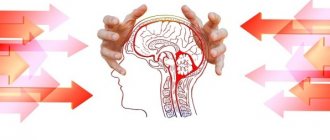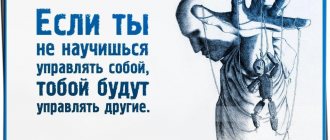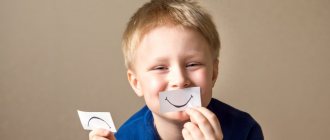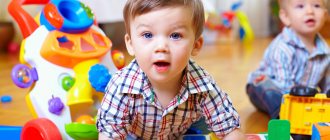We invite you to get acquainted with the main indicators of child development. They will help interested parties (parents, caregivers, teachers) determine the degree of development of a particular child and, if necessary, take appropriate corrective measures.
When compiling these indicators, we used the book’s author Elena Volosova’s own scientific and methodological research, long-term observations of young children, as well as materials from the work “Diagnostics of the neuropsychic development of children in the first three years of life” (TsOLIU doctors, M., 1979) and Basic preschool child development program “Origins” (named after A.V. Zaporozhets, M., 1997).
Cognitive development
Difference between objects by characteristics:
Names correctly the four primary colors and some shades of colors.
Orients himself in the seven colors of the spectrum (knows black and white), finds according to a pattern, at the request of an adult.
Collects sequentially (puts smaller ones into larger ones) nesting dolls, bowls, molds, caps from four to six components (as shown, at the request of an adult, in independent play).
Easily matches flat geometric shapes to a sample (circle, rectangle, triangle, trapezoid, oval, square).
Visually navigates the configuration of three-dimensional geometric shapes (matches them to the corresponding holes). He names some of them: ball, cube, prism (“roof”), cylinder (“column”), brick, cone.
Identifies by touch (in the game) and names familiar geometric or other figures.
Assembles a pyramid of eight to ten rings according to a pattern or pattern (in descending size, in size and color, in shape and size).
Finds and can name a large, a small object, a medium one - between them.
Identifies an object by its texture (soft, hard).
Composes a picture from two parts (in class).
Matches the mosaic to a simple pattern.
Remembers and indicates the place where the toy removed by the adult stood (in a joint game).
Imitates the writing of an adult (imitates).
An adult can add missing details to a drawing (a stem for a flower, a leaf for a branch).
Draws circles, ovals, draws lines, depicts rectangular objects; paints over; imitates the model.
He draws according to his own ideas. Explains what he is drawing (sun, path, rain, etc.).
Rolls out lumps of clay and plasticine in palms; connects the parts.
Sculpts simple shapes (ball, column, sausage, bagel).
Performs simple applique from ready-made forms.
Game actions (start of role-playing game):
Shows initiative in the game (creativity). Can “take on a role” (calls himself “mother”, “doctor”, etc. in the game). Understands his role in the game.
Fantasizes in the game (introduction of a fairy-tale character).
Plays calmly with other children using substitute objects.
Imitates other children (in any games).
Follows the rules in outdoor games.
Builds a house, a fence, a car, a bridge, etc. from cubes (according to a model, according to a drawing, according to verbal instructions, according to a plan)
Uses various three-dimensional geometric shapes in building games and design, plays with buildings with toys.
Social-emotional development
Wants to be good, expects praise, approval, emotional and positive reinforcement from an adult.
Shows initiative and independence.
Experiences emotional satisfaction if he was able to accomplish something. I'm happy when they praise me.
Shows a sense of pride in himself (“I’m the best runner”), in his parents (“Dad is the strongest,” “Mom is the most beautiful”).
Inquisitive, curious.
Long-term memory relies on previous emotional experiences, and memories from the past year may arise.
Shows emotional restraint: does not shout in public places, calmly crosses the street with an adult, does not run along the sidewalk, calmly listens to an adult’s request and fulfills it, stops crying when there is a justified prohibition.
Disobedient, emotionally tense when movements are limited, when adults do not understand his requests and desires. Can be persistent in its demands.
He worries if they scold him. He may be offended for a long time by punishment.
Feels sad and ashamed. He understands that he did something badly (he didn’t have time to go to the toilet, he spilled water); he expects a negative assessment from an adult.
He understands if someone else is doing something bad. Gives an emotionally negative assessment (“You can’t: offend, break, tear, take away, fight”).
Can be jealous, offended, intercede, angry, disingenuous, mischievous.
Knows non-verbal methods of emotional communication. Expresses his feelings with his gaze, facial expressions, tone, gestures, expressive movements, and poses.
Emotionally expresses imaginary situations (in play).
Speech is filled with emotionally expressive shades (often by imitation).
The word denotes his emotional states: laughing, afraid, frozen.
Fears and fear of the dark may arise.
Begins to understand humor (laughs, puzzled).
Emotionally empathizes with characters when listening to fairy tales, when watching children's plays, cartoons (he is happy, sad, angry, winces in “pain,” etc.).
Emotionally responsive (experiences pleasure) to music, singing, artistic expression. Sings along, dances (passes the rhythm). Reacts to changes in music - moves differently (spinning, crouching, waving his arms, clapping, stomping).
Reacts emotionally differently to familiar and unfamiliar pieces of music or art when looking at illustrations.
Prefers cheerful music and songs, bright drawings.
Shows interest in drawing and modeling.
Experiences emotional satisfaction from outdoor games.
Emotionally reacts differently to the beautiful and ugly (notices, distinguishes, evaluates).
Emotionally anticipates the outcome of certain actions (one's own or other people's).
Gets upset when you can't do something.
He rejoices at his skillful actions when he succeeds.
Friendly, emotionally open, treats people with trust. He is interested in their actions (deeds), answers if they ask about something.
Remembers kind and harsh people (emotionally responsive and emotionally restrained).
Shows shyness with characteristic facial expressions, especially when addressed by a stranger.
Understands the state of others based on his own emotional experience.
Emotionally assesses the situation: empathizes (if someone is in pain), helps (if someone needs help), sympathizes, behaves quietly (if someone is sleeping, tired).
Notices the sadness, dissatisfaction, and joy of adults or children.
Imitates facial expressions, voice intonations, and emotional and expressive movements of close adults.
Imitates the emotional behavior of peers (can copy someone who is noisier or louder).
Treats children kindly: does not snatch toys, does not take them without asking, and shares his toys.
Enjoys communicating with peers. There is an interest in playing games together.
Shows affection for some children.
Wary of unfamiliar animals, individual people, and new situations.
Blame others for their failures
This habit is expressive, unprofessional, and not typical of a person with a high IQ. Trying to blame other people for your failures does not characterize the smartest person. People with low IQs prefer not to be responsible for wrong decisions; it is better for them to “wallow” in self-pity or simply blame others for everything.
T. Bradberry, author of Emotional Intelligence 2.0, says: “Don't blame or shift responsibility to someone else. If you played a role—even a small one—in a particular case and something went wrong, admit it,” says Bradbury. “Once you start blaming others for your failures, others will begin to perceive you as someone who is not responsible for his actions.”
An indicator of high intelligence is the recognition that a mistake is a chance to gain new experience. J. S. Moser from the University of Michigan, in the course of his research, came to the conclusion that the brains of intelligent individuals react to mistakes and failures in different ways.
Speech development (up to 1500 spoken words)
Pronounces complex sentences when communicating. Uses words to express desires, feelings, impressions.
Speaks in simple, grammatical phrases.
He often accompanies his actions with speech. Begins to use subordinate clauses (not always).
Changes words according to numbers and cases. Asks cognitive questions: “Where?”, “Where to?”, “Why?”, “When?” and others. Easily repeats unfamiliar words and phrases after adults. Quickly learns poems, songs, excerpts from fairy tales. Pronounces many sounds correctly (vowels and simple consonants).
Word creation and a tendency to rhyme appear. Enters into verbal dialogues with children and adults. Answers questions from an adult based on the plot picture. Names some animals (their babies), household items, clothes, dishes, equipment, plants and more from a picture.
Tells a familiar fairy tale coherently based on the picture. Conveys with words, gestures, and intonation the content of a fairy tale, nursery rhyme, song, or poem. Speaks out about a book, an event (after questions and based on memory).
Can prove and think through a sentence said by an adult.
Quickly answers the question: “What is your name?” Knows his last name.
Answers the question: “How old are you?” Points with fingers.
Distinguishes and names people by their gender and age (boy, uncle, grandfather, girl, aunt, grandmother).
Knows his gender: boy or girl; names after the adult’s question.
Knows the names of body parts (head, neck, back, chest, stomach, arms, legs, fingers).
Knows the purpose of body parts (answers questions): “eyes look”, “ears listen”, “legs walk”).
Knows the names of the same parts of the body in humans and animals: “everyone has eyes, legs - a person, paws - an animal, hands - a person, wings - a bird.”
In the game he calls himself some kind of character. Answers an adult’s question: “Who are you in the game?”
When playing, he accompanies his actions with words.
Uses role-playing speech in the game. Speaks for himself and for the doll.
He recognizes and names the whole image by detail (by the trunk - an elephant, by the trousers - a boy).
Has an idea of numbers, shows and says: “one, two, three, many, few.”
Anticipates the outcome (mental possibilities). Uses means to achieve goals.
Able to observe for a long time, concentrate attention, and get carried away by his activities.
Begins to distinguish between the right and left sides (may be mistaken).
Summarizes objects according to their properties (who (what) flies? who (what) swims?).
Shifts from calling himself in the third person to the pronoun “I”.
Shows special interest in conversations between adults.
Listens for a long time to a fairy tale, read or told to adults or recorded on audio cassettes.
Article “Features of communication and speech development of mentally retarded children”
Liliya Potapova
Article “Features of communication and speech development of mentally retarded children”
Features of communication of mentally retarded children.
Each person occupies a very specific place in society and, therefore, is always in appropriate relationships with the people around him. Through the process of communication , a person has the opportunity to understand himself and other people, evaluate their feelings and actions, and this, in turn, realize himself and his opportunities in life and take his own place in society . Consequently, communication is the most important factor in the formation of personality, one of the main types of human activity, aimed at knowing and assessing oneself through interaction with other people. As L. S. Vygotsky believed, the development of the human psyche occurs only in joint activity and communication . Violations in the sphere of communication affect the development of personality . Children's self- image is distorted , making it difficult for the child to understand himself as an individual, which leads to difficulties in interpersonal relationships.
For a child with intellectual disabilities, learning to communicate is of great importance. If a child is able to express his desires, needs, ask for help and respond to the words of people talking to him, he will be able to enter the big world. This ability will be the means by which he adapts to the world around him and learns to live in it.
The need for communication is not innate. It arises in the course of life and functions, is formed in the life practice of the child’s interaction with others. The need to communicate with adults arises at the beginning as a biological need based on primary organic needs, then social needs for new sensations arise.
The development of the personality of any person, especially a disabled person with mental disorders, is influenced by his immediate environment - parents, relatives. Teachers and educators are also surrounded by mentally retarded children and undoubtedly influence the development of their personality . The ordinary people people with mental retardation encounter in everyday life also have an impact.
Children with severe intellectual disabilities have difficulty understanding other people's speech; they capture the tone, intonation, facial expressions of the speaker and individual supporting words, mostly associated with their immediate needs. The development and improvement of communication skills in a mentally retarded child at different stages of life - from birth to adulthood - requires a lot of attention and patience from teachers, psychologists, and parents. Teachers and parents should closely monitor his behavioral and speech reactions in all types of activities to help and guide the development of communication skills.
Observing the facial expression of a mentally retarded and the development of his senses should not remain outside the field of view of teachers. Various activities, exercises and the use of household items will bring considerable benefits in this direction. mentally retarded child often needs to be taught everything, even to smile. It is known that a smile appears only under the influence of social factors, and is not given to us from birth. with mentally retarded children, accompanying your actions with smooth, quiet speech with a calm, friendly intonation. You need to talk to them more, naming the actions that are being performed. It is necessary to constantly maintain attention and cognitive interest in the activity being performed and the environment.
Features of speech development of children with severe mental retardation.
Closely related to severe intellectual impairment in severely mentally retarded children is profound underdevelopment of speech . The degree of underdevelopment most often corresponds to the degree of general mental underdevelopment and depends on the characteristics of motor speech development . In some cases, this is a stream of meaningless cliched phrases with the preservation of previously heard intonations. In other cases, speech does not arise and hardly develops for a number of years . These are the so-called “ speechless ”
children.
These children are heterogeneous in their condition. Some people are indifferent to the environment and do not use speech. Others constantly utter one monotonous sound, which is not a means of communication . Several more people use non-verbal means (pointing with their fingers at the desired object or toy)
.
This group is the most difficult in speech , regardless of age, and makes up 20-25% of the total number of severely mentally retarded children .
The speech development of a child with a pronounced degree of intellectual disability is characterized by late stages of function formation, long periods of formation of speech mechanisms and qualitative inferiority in the implementation of speech utterances . At an early age, such children have delayed development of preverbal forms of communication. They are indifferent to their surroundings and, as a rule, do not respond to attempts at communication . They lack the animation complex (motor reaction, smiling, humming)
.
The timing of the appearance of babbling and the first words is delayed. Many of them develop individual words by the age of 5-6 years. These children have a very limited understanding of speech addressed to them. Speech is not a regulator of their behavior. Own speech is so poorly developed that it cannot perform the function of communication . In some children, with a fairly wide vocabulary, echolalic, meaningless speech is recorded, consisting of a certain set of speech cliches . The underdevelopment of the communicative function of speech, unfortunately, is not compensated by other means of communication , in particular non-verbal (facial expressions, gestures)
.
Children do not understand gestures well and cannot spontaneously master communicative gestures. This distinguishes them from children with other psychophysical disorders (hearing, speech, etc.)
.
Sound pronunciation is grossly impaired due to the anatomical and functional characteristics of the speech apparatus (pathology of the structure, decreased muscle tone, impaired voluntary movement, gross underdevelopment of phonemic hearing and perception. The volume of auditory memory is reduced, which limits the amount of lexical means the child can assimilate.
Underdevelopment of perception processes can be effectively corrected if implement a systematic approach. Step-by-step distribution of practical material is carried out in accordance with their special capabilities . The sequence of formation of each skill is determined by the level of formation of the previous (basic)
skills, the stages of its
development in ontogenesis and the presence of workarounds for its formation.
Bibliography:
1. Shipitsina L. M. Teaching communication to a mentally retarded child . – St. Petersburg, 2010.
2. Shipitsyna L. M. Development of communication skills for persons with intellectual disabilities. – St. Petersburg, 2000.
Physical development
Performs as shown, according to verbal instructions, independently:
Performs two actions simultaneously: stomping and clapping. Swinging on a swing. Slides down on a sled. Rides a tricycle. Learns to ski.
Not afraid to swim when supported by an adult. Easily steps over obstacles on the floor (blocks) in alternating steps. Quickly passes along an inclined board. Jumps over the line on the floor. Standing long jump on two legs. Jumps from a small height. Runs, jumps. Throws and catches the ball. Imitates the movements of peers: runs, jumps, throws, crawls, spins.
From the book by E. Volosova “Development of an early child” (main indicators), M.: “Linka-Press”, 1999.
React angrily and aggressively to arguments
Of course, a high level of intelligence is not determined by constant calm; even the most intelligent people get angry. But for a low IQ, aggression is literally synonymous with getting out of a situation that is not going according to their plan. When there is a feeling of lack of control of the situation according to their ideas, such people tend to use anger to prove their position.
Scientists from the University of Michigan in a study clearly showed the relationship between aggression and low IQ. In their final report, they stated: “We think that people with low IQs react aggressively from an early age. Such angry manifestations complicate the child’s mental and social development, leading to the appearance of certain disorders.”










